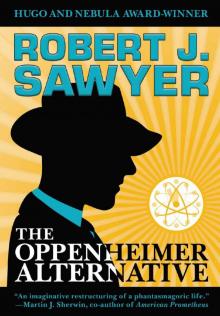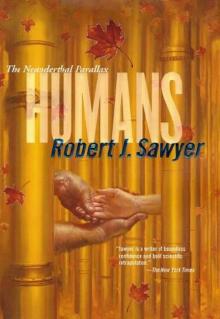- Home
- Robert J. Sawyer
Hybrids np-3 Page 10
Hybrids np-3 Read online
Page 10
Mary nodded timidly. She’d left Ponter at his home, and had journeyed by travel cube to Lurt’s house in Saldak Center. “That’s right.”
Lurt opened her arms and gave Mary a big hug. “Wonderful!” she said. “Absolutely wonderful!”
Mary felt her whole body relaxing. “I didn’t know if you would approve.”
“Why would I not approve?” asked Lurt. “Ponter is a wonderful person, and you are a wonderful person. You will make terrific parents.” She paused. “I cannot tell with you Gliksins. How old are you, my dear?”
“Thirty-nine years,” replied Mary. “About five hundred and twenty months.”
Lurt lowered her voice. “For our kind, it is difficult to conceive by that age.”
“Mine, too, although we have all sorts of drugs and techniques that can help. But there is one little problem…” “Oh?”
“Yes. Barasts, like you and Ponter, have twenty-four pairs of chromosomes. Gliksins like me have only twenty-three.”
Lurt frowned. “That will make fertilization very difficult.”
Mary nodded. “Oh, yes. I doubt we could do it at all just by having sex.”
“Do not give up trying, though!” said Lurt, grinning.
Mary grinned back. “Not a chance. But I was hoping to find a way that we could combine Ponter’s DNA and mine. One of the chromosomes in my kind formed from the union of two of the chromosomes in the common ancestor we both share. Genetically, the actual content of the DNA sequences is very similar, but it happens to all be on one long chromosome in Homo sapiens, instead of two shorter ones in Homo neanderthalensis.”
Lurt was nodding slowly. “And you hope to overcome this problem?”
“That was my thought. I think it could be done, even just with the techniques my people have available, but it would be very tricky. But your people are further along in a lot of ways. I was wondering if you knew anyone who might be an expert in this area?”
“I very much like you, Mare, but you do have a tendency to put your foot right in it.”
“Pardon?”
“There is a solution to your problem—a perfect solution. But…”
“But what?”
“But it is banned.”
“Banned? Why?”
“Because of the danger it posed to our way of life. There was a geneticist named Vissan Lennet. Until four months ago, she lived in Kraldak.”
“Which is?”
“A town perhaps 350,000 armspans south of here. But she left.”
“She left Kraldak?” said Mary.
But Lurt shook her head. “She left everything.”
Mary felt her eyebrows shooting up. “My God—do you mean she killed herself?”
“What? No, she is still alive. At least, as far as anyone knows—not that we have any way to contact her.”
Mary gestured at Lurt’s forearm. “Can’t you just call her up?”
“No. That is what I am trying to say. Vissan left our society. She gouged out her Companion and went to live in the wilderness.”
“Why would she do that?”
“Vissan was a great geneticist, but she had developed a device the High Gray Council could not countenance. In fact, the local High Grays called me and asked my opinion of it. I did not want to see research suppressed, but the High Grays felt they had no choice, given what Vissan had done.”
“Good Christ, you make it sound as though she created some sort of genetic weapon!”
“What? No, no, of course not. She was not a lunatic. The device Vissan built was a…a ‘codon writer,’ I suppose would be the correct phrase. It could be programmed to output any sequence of deoxyribonucleic acid or ribonucleic acid imaginable, along with associated proteins. If you could think it up, Vissan’s codon writer could produce it.”
“Really? Wow! That sounds amazingly useful.”
“It was too useful, at least according to the High Gray Council. You see, among many other things, it allowed the production of…of…I am not sure of your word: the half-sets of chromosomes that exist in sex cells.”
“Haploid sets,” said Mary. “The twenty-three—excuse me, twenty- four chromosomes—that are found in sperm or eggs.”
“Exactly.”
“But why would that be a problem?” asked Mary.
“Because of our system of justice,” said Lurt. “Do you not see? When we sterilize a criminal and his or her close relatives, we are preventing them from producing haploid chromosome sets; we are preventing them from being able to reproduce. But Vissan’s codon writer would have allowed the sterilized to circumvent their punishment, and still pass their genes on to the next generation, by simply programming the device to produce chromosomes for them containing their own genetic information.”
“And that’s why the device was banned?”
“Exactly,” said Lurt. “The High Grays ordered the research halted—and Vissan was furious. She said she could not be part of a society that suppressed knowledge, and so she left.”
“So…so Vissan is living off the land?”
Lurt nodded. “It is easy enough to do. As youths, we are all trained in the required skills.”
“But…but it’s soon going to be the dead of winter.”
“Doubtless she will have built a cabin or some other shelter. In any event, Vissan’s codon writer is the device you need. There was only one prototype built, before the High Gray Council banned it. Normally, of course, nothing can go missing in this world: the Companion implants see and record all. But Vissan disposed of the prototype after she had gouged out her Companion, and while she was alone. The prototype likely still exists, and it is clearly the ideal tool for making the hybrid child you desire.”
“If I can only find it,” said Mary.
“Exactly,” said Lurt. “If you can only find it.”
Chapter Fourteen
“And it was that questing spirit that let Eagle and Columbia, Intrepid and Yankee Clipper, Aquarius and Odyssey, Antares and Kitty Hawk, Falcon and Endeavour, Orion and Casper, and Challenger and America fly to the moon…”
Mary’s permanent Companion implant had to be installed by a Neanderthal surgeon. Prior to the operation, Mary had returned to the equipment room above the Debral mine where her temporary unit had originally been strapped on, since that was the only place at which its clasps would open. Then, accompanied by two burly Neanderthal enforcers, Mary had been taken to the hospital in Saldak Center.
The surgeon, a female named Korbonon, was a member of generation 145, about Mary’s age. Korbonon normally worked on repairing severely damaged limbs, such as those that sometimes resulted when a hunt went horribly wrong; her knowledge of musculature and nerve tissue was second to none.
“This is going to be a bit tricky,” said Korbonon. The temporary Companion was sitting on a small table, hooked up to an external power source; it was unattached to Mary, but still doing translations for her, through its external speaker. Korbonon clearly wasn’t used to having her speech translated; she spoke loudly, as if Mary could understand her Neanderthal words. “Your forearm is less muscled than a Barast one, which may make anchoring the Companion difficult. But I see what they said about Gliksin proportions is true: your upper and lower arms are the same length; that should give us some extra territory to work with.” Barast forearms were noticeably shorter than their upper arms; their shins were also shorter than their thighs.
“I would have thought this was a routine operation,” said Mary.
Korbonon’s eyebrow was a light reddish blond. It rose. “Routine? Not adding a first Companion to an adult arm. Of course, when the Companions were introduced, almost a thousand months ago, they were mostly installed in adults—but the surgeons who did that then are all long dead. No, this operation has only been occasionally performed since, mostly on those who have lost the arm that contained the implant they received in childhood.”
“Ah,” said Mary. She was leaning back in something that vaguely resembled a dentist’s chair with stirrups—app
arently an all-purpose operating platform. Her left arm was sitting on a little table that protruded from one side of the chair. The inside of her arm had been swabbed with something that wasn’t alcohol—it was a pink liquid that smelled sour, but apparently served the purpose of disinfecting the skin. Still, Mary was surprised to see that Korbonon wasn’t wearing a face mask. “Our surgeons usually cover their noses and mouths,” said Mary, a bit concerned.
“Why?” asked Korbonon.
“To keep them from infecting the patient, and the patient from infecting them.”
“I might as well operate blindfolded!” declared Korbonon.
Mary was about to question the statement, then realized what the surgeon meant: the acute Neanderthal sense of smell provided a crucial part of their perception.
“What will you do about anesthetic?” asked Mary. For the first time, she was grateful that Ponter wasn’t here. Knowing his sense of humor, he would have doubtless quipped, “Anesthetic? What is that?”—to be followed, of course, after a suitable pause, with “Just kidding.” She was nervous enough as it was.
“We will use a neuronal interrupter,” replied Korbonon.
“Really?” said Mary, the scientist in her coming to the fore, despite her apprehension about the operation. “We use chemical agents.”
The surgeon nodded. “We used to do that,” she said, “but they take time to become effective, time to wear off, and are difficult to localize precisely. Also, of course, some people have allergies to chemical anesthetics.”
“Yet another technology my people will doubtless want to trade for,” said Mary. A second female loomed in—Mary didn’t know anything about Barast medical hierarchies; she might have been a nurse or another doctor, or held some position that had no counterpart in the Gliksin world. In any event, she wrapped an elastic metalized band around Mary’s left forearm just below the elbow, and then attached another one just above the wrist. Then, to Mary’s astonishment, she took out what looked like a fat Magic Marker, and started drawing a complexseries of lines between the two bands. Rather than ink, though, what looked like liquid metal came out. But it wasn’t hot, and it quickly dried, gaining a matte finish as it did so. The color was wrong, but the effect was like that chocolate syrup for ice cream that hardens quickly into a crust. “What are you doing?” asked Mary.
The Barast with the marker made no reply. But the surgeon said, “She is tracing the appropriate nerve trunks in your forearm. The lines form electrical connections between the two destabilizers.”
After a few minutes, the second female nodded, apparently to herself, and moved away, approaching a small control console. She pulled out a series of control buds, and Mary felt her forearm go numb. “Wow,” she said.
“All right,” said Korbonon. “Here we go.” And before Mary knew what was happening, the surgeon had dived in and made a long incision parallel to Mary’s radius. Mary almost threw up as her own blood welled out, spilling onto the little table, which she now noted had a raised lip all around its edge.
Mary was shocked—and was worried about going into shock. In her world, great efforts were taken to keep patients from being able to see themselves during surgery. But here, no thought had been given to that. Maybe having to kill your own food, even occasionally, was enough to put an end to such squeamishness. Mary swallowed hard and tried to calm herself; it really wasn’t that much blood…was it?
She wondered what happened during thoracic surgery. Gliksin surgeons were presented with a patient whose face was covered, and had only a tiny, exposed surgical field. Did the Barasts do it that way, too? The main reason, after all, wasn’t to keep the patient from getting covered with blood. Rather, Mary had been told by one of her doctor friends, it was a psychological aid for the surgeon—a way of keeping him or her focused on the problem in cutting and splicing, rather than thinking of themselves as carving into the home of another human soul. But the Barasts, with their complete lack of Cartesian duality and their indifference to gore, perhaps had no such need.
Korbonon slipped several blue springlike things into the wound that apparently did the same job as forceps, holding it open. Other little clips and doodads were attached to arteries, veins, and nerves. Mary could clearly see into the opening in her skin, cutting through fat and meat all the way down to the slick grayish solidity of her radius.
Moments later, the other Barast—the one who had painted the nerve-deadening lines on Mary’s forearm—moved in. The Barast doctors were wearing short-sleeved yellow shirts and long blue gloves that went past their elbows; Mary thought perhaps they went that high to keep blood from getting matted into their hairy forearms.
The second Barast picked up Mary’s new Companion and removed it from its sterile wrapping. Mary had gotten used to the look of the faceplates, but had never seen the other side of one. It was sculpted like a topographic model, with highs, lows, and channels, presumably to accommodate blood vessels. Mary watched in queasy fascination as her own radial artery—the suicide’s favorite—was severed. It was quickly clamped at both ends, but not before a tube of blood a foot long had shot out.
Mary winced, wondering how Vissan Lennet, the creator of the codon writer, had managed to self-perform the removal of her Companion; it must have been horrendously difficult.
The surgeon next used a laser scalpel, similar to the one Mary herself had had to use when Ponter was shot outside the United Nations. The two ends of Mary’s radial artery were attached to two different apertures on the underside of the Companion. She knew the Companions had no power source of their own; they were fueled by bodily processes. Well, the pumping strength of blood through the radial artery was certainly a good source of power; apparently the Companion had a hydroelectric—or would that be sanguinoelectric?—generating plant built in.
Mary kept meaning to turn away—just as she always quickly hustled past the TV series The Operation on The Learning Channel when surfing. But it really was interesting in an awful sort of way. She watched as the Companion installation was completed, the blood vessels cauterized, and her skin sealed by minute laser blasts. Finally a puttylike caulking was extruded all around the edges of her Companion, apparently to promote healing.
By comparison, the remaining surgery—inserting the two cochlear implants—was minor, or so it seemed, although that might have just been a consequence of Mary being unable to see that part of the operation.
At last, it was all done. Mary’s arm had been wiped clean of blood, the protective film had been removed from the Companion’s faceplate, and the cochlear implants had had their output balanced and tuned.
“All right,” said the surgeon, reaching down to Mary’s forearm and pulling out a small beadlike control bud, one of six, each a different color. “Here you go.”
“Hello, Mary,” said a synthesized voice. It sounded as though it were coming from the middle of her head, exactly between her ears. The voice was Neanderthaloid—deep, resonant, probably female—but it managed the ee phoneme in Mary’s name perfectly; clearly, that problem had been addressed and solved.
“Hello,” said Mary. “Um, what should I call you?”
“Whatever you wish.”
Mary frowned, then: “How about Christine?” Christine was Mary’s sister’s name.
“That’s fine,” said the voice in her head. “Of course, if you change your mind, you’re free to rename me as often as you like.”
“Okay,” said Mary, then: “Say, did you say ‘that’s’ and ‘you’re’?”
“Yes.”
Mary made an impressed face. “So you can use contractions! Ponter’s Companion can’t.”
“It wasn’t a difficult programming issue,” said Christine, “once the underlying concept was grasped.”
Mary was startled by a tap on her shoulder. She’d blanked out the exterior world while talking with the Companion; she wondered if she had tilted her head the way Neanderthals routinely did—whether that was something that happened naturally, or was a l
earned behavior, a courtesy to let others know that you were momentarily preoccupied.
“So,” said the surgeon, smiling down at Mary, who was still seated in the operating chair. “I take it your Companion is working?” For the first time, Mary heard a translation the way Ponter did—not through an external earpiece, but as words flowering full-blown in her head. The Companion was a good mimic; although the English words were emphasized at bizarre points—as if William Shatner were saying them—they were presented in a voice much like the surgeon’s own.
“Yes, indeed,” said Mary—and as soon as she’d finished, her Companion’s external speaker announced what Mary recognized as the Neanderthal equivalent: “Ka pan ka. ”
“All right, then,” said the woman, still smiling. “That’s it.”
“Is my Companion transmitting to my alibi archive?”
“Yes,” replied the surgeon, and “I am,” said Christine in her own voice after translating the surgeon’s “Ka. ”
Mary got out of the chair, thanked the surgeon and her colleague, and headed on her way. When she came to the medical facility’s lobby, she saw four male Neanderthals, each of which seemed to have a broken arm or leg. One was dressed in the silver of an Exhibitionist. Mary figured such a person wouldn’t be offended by questions, so she walked up to him and said, “What happened?”
“To us?” asked the Exhibitionist. “Just the usual: hunting injuries.”
Mary thought of Erik Trinkaus and his observation that ancient Neanderthals often had injuries similar to those of rodeo riders. “What were you hunting?”
“Moose,” said the Exhibitionist.
Mary was disappointed that it wasn’t something more exotic. “Is it worth it?” she asked. “The injuries I mean?”
The Exhibitionist shrugged. “Getting to eat moose is. There’s only so much passenger pigeon and buffalo you can take.”
“Well,” said Mary, “I hope they get you all fixed up quickly.”
“Oh, they will,” said the Exhibitionist with a smile.
Mary said goodbye and left the hospital, going out into the late-afternoon sun; she’d probably given the Exhibitionist’s audience quite a treat.

 The Oppenheimer Alternative
The Oppenheimer Alternative Factoring Humanity
Factoring Humanity The Shoulders of Giants
The Shoulders of Giants Stream of Consciousness
Stream of Consciousness End of an Era
End of an Era The Terminal Experiment
The Terminal Experiment Far-Seer
Far-Seer Mindscan
Mindscan You See But You Do Not Observe
You See But You Do Not Observe Star Light, Star Bright
Star Light, Star Bright Wonder
Wonder Wiping Out
Wiping Out Flashforward
Flashforward Above It All
Above It All Frameshift
Frameshift The Neanderthal Parallax, Book One - Hominids
The Neanderthal Parallax, Book One - Hominids Foreigner
Foreigner Neanderthal Parallax 1 - Hominids
Neanderthal Parallax 1 - Hominids Relativity
Relativity Identity Theft
Identity Theft Hybrids np-3
Hybrids np-3 Foreigner qa-3
Foreigner qa-3 WWW: Watch
WWW: Watch Calculating God
Calculating God The Terminal Experiment (v5)
The Terminal Experiment (v5) Peking Man
Peking Man The Hand You're Dealt
The Hand You're Dealt Illegal Alien
Illegal Alien Neanderthal Parallax 3 - Hybrids
Neanderthal Parallax 3 - Hybrids Fossil Hunter
Fossil Hunter WWW: Wonder
WWW: Wonder Iterations
Iterations Red Planet Blues
Red Planet Blues Rollback
Rollback Watch w-2
Watch w-2 Gator
Gator Triggers
Triggers Neanderthal Parallax 2 - Humans
Neanderthal Parallax 2 - Humans Wonder w-3
Wonder w-3 Wake
Wake Just Like Old Times
Just Like Old Times Wake w-1
Wake w-1 Fallen Angel
Fallen Angel Hybrids
Hybrids Hominids tnp-1
Hominids tnp-1 Far-Seer qa-1
Far-Seer qa-1 Starplex
Starplex Hominids
Hominids Identity Theft and Other Stories
Identity Theft and Other Stories Watch
Watch Golden Fleece
Golden Fleece Quantum Night
Quantum Night Fossil Hunter qa-2
Fossil Hunter qa-2 Humans np-2
Humans np-2 Biding Time
Biding Time